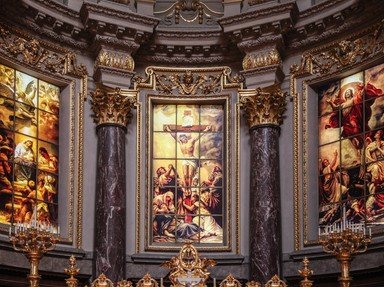Quiz Answer Key and Fun Facts
1. This man is one of the most famous sainted sinners of all time, a masterful theologian from northern Africa. Despite the prayers of his Christian mother, St. Monica, this young man loved wine, women and song, and followed Manichean ideas of an evenly matched battle between good and evil. In his late twenties, however, he turned to Christianity and spent the rest of his life developing ideas from original sin to just warfare. Who was this saint and Doctor of the Church?
2. Sin was a controversial topic when St. Callixtus was elected pope in 217. At the time, standard Christian practice was to postpone baptism as late as possible -- because baptism washed away all prior sins, but mortal sins committed after baptism might cut one off from God and the Church. St. Callixtus took a more merciful view, having lived a life of sin himself. Which of these terrible crimes did he commit?
3. St. Vladimir (c. 956-1015) is famous for converting the Rus to Christianity, but many of this Kievan grand prince's most memorable deeds are more properly infamous than famous. Which of these sins is he NOT alleged to have committed?
4. St. Mary of Egypt (circa 344 - 421) ran away to the big city of Alexandria at the age of 12, entranced by the prospect of a life of fun and sin. "I did free of charge what gave me pleasure," she told St. Zosimas, whom she met at the end of her life, "and ... there is no mentionable or unmentionable depravity" she could not lay claim to. But this life ended in Jerusalem, where she experienced a miracle that turned her life around. What was it?
5. St. Dismas is the name tradition gives to a man who was a sinner and a criminal his entire life, repenting only on his last day on Earth. Nevertheless, he was blessed with a personal guarantee of salvation from the dying Jesus Christ. According to the Gospels, for what crime was St. Dismas executed by the Romans?
6. St. Pelagia, a 5th-century dancer and seductress, was so precious to the Devil that he is said to have visited her the night after she repented and was baptized. "What evil have I ever done to you?" he asked. "Tell me how I have offended, and I will give you whatever you want." According to this story (related by James the Deacon), why did the devil want St. Pelagia's soul so badly?
7. As a young boy, St. Ignatius of Loyola fell prey to an underappreciated deadly sin: pride. Desperate to achieve personal glory and honor, he pursued first gambling, then duelling and women. At 26, he joined in the defense of Pamplona -- and was seriously injured after he ignored orders to surrender. The episode left him not with glory but with gravely injured legs, and in his slow recovery he discovered God. What religious order did he go on to found?
8. Many sainted sinners seemed to go directly from from the depths of vice to the heights of virtue, with nary a look back. St. Moses the Ethiopian followed a more nuanced path. After he gave up banditry, sex, and violence to follow God, he struggled for the rest of his life to truly leave behind his sins. Where did St. Moses live and struggle after converting to Christianity?
9. When Christ Himself calls you a sinner, there's not much you can say to object. This apostle and Gospel writer was collecting taxes and generally fleecing the public when Jesus called him to his flock -- prompting one of the Pharisees' first criticisms of him. Who is this evangelist, also known as Levi?
10. The Vikings spent centuries terrorizing much of Europe, raiding villages and massacring monks -- not exactly the stuff of sainthood! Yet St. Olaf (995-1030) was a Viking himself, and an enthusiastic one at that. Nor did he allow his teenage conversion to Christianity to inhibit his lifestyle, although it did redirect him somewhat. On seizing power in Norway, what means did he primarily use to Christianize the country?
Source: Author
CellarDoor
This quiz was reviewed by FunTrivia editor
gtho4 before going online.
Any errors found in FunTrivia content are routinely corrected through our feedback system.

